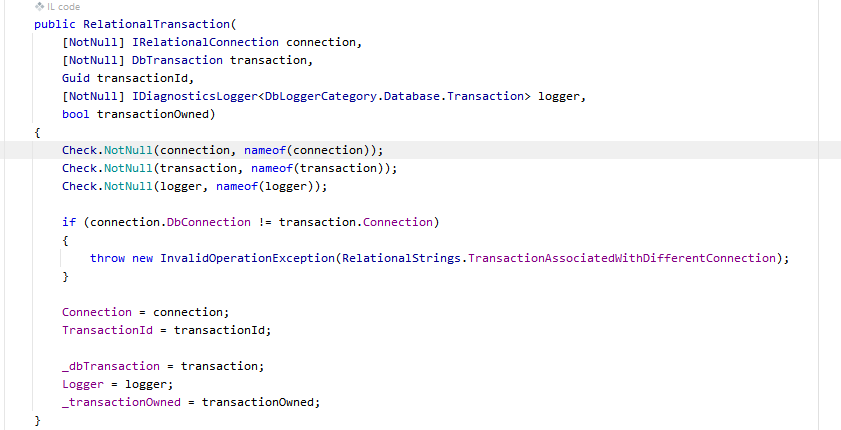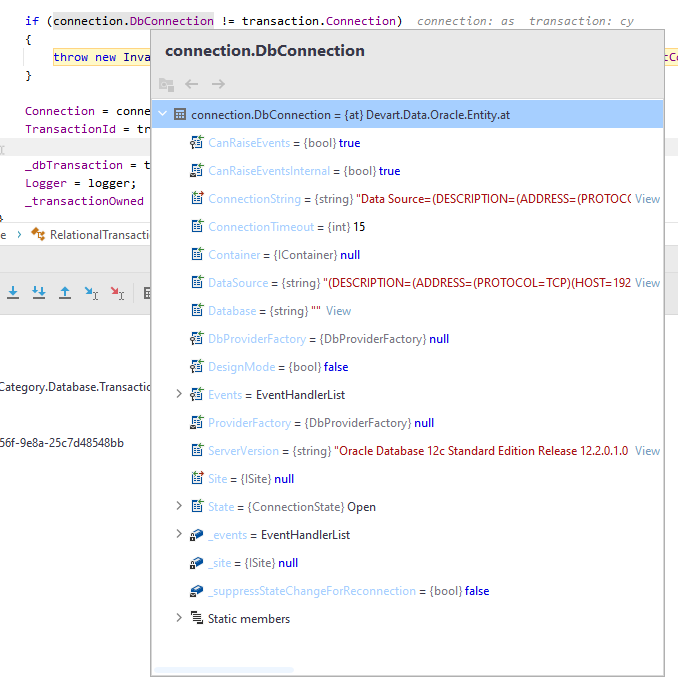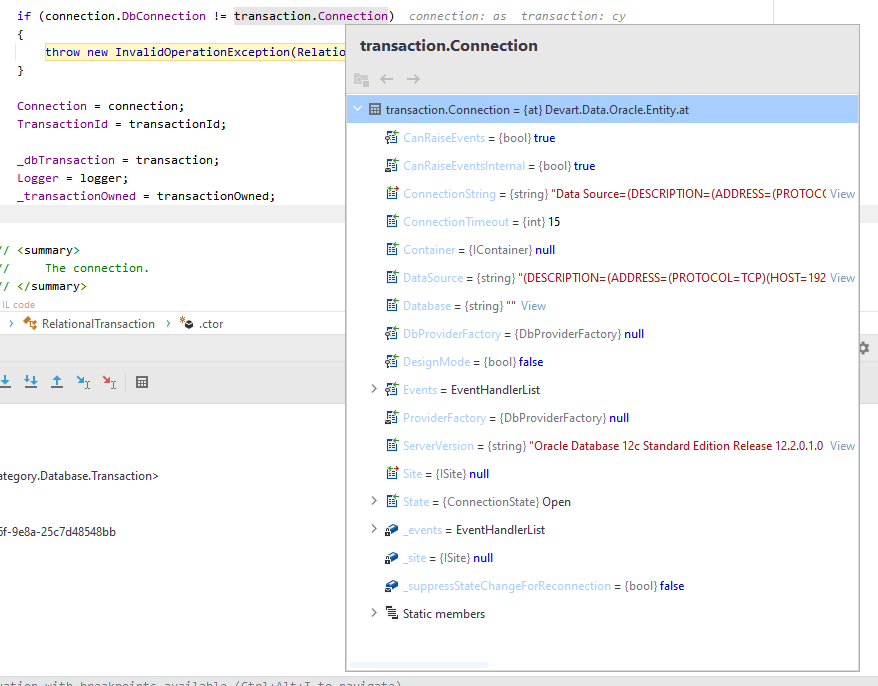Activities of "bhyatz"
@alper. We have all our code already deployed to production with the devart driver and the migrations for the versions have all been done with devart. Changing to the oracle provider may break our deployed code.
We also have a large amount of data in our production database, and it will not be easy to change our migrations from devart to oracle if the oracle migrations are not compatible with devart. We have 243 entities and large volume of data already in the entities.
@alper . Is there an estimated time when this issue will be resolved as it is preventing us from updating to version 4. We are still on version 3.0.4.
@alper. The database creation does not break. You need to run the Dbmigrator project. The code breaks in the data seeding. I followed your steps again. but when I run the DbMigrator project I get the error.
C:\tmp\abp\aspnet-core\src\NexBase.EntityFrameworkCore.DbMigrations>dotnet ef -s ..\NexBase.DbMigrator database update Build started... Build succeeded. The Entity Framework tools version '5.0.3' is older than that of the runtime '5.0.4'. Update the tools for the latest features and bug fixes. Applying migration '20210310150827_Initial'. Done.
C:\tmp\abp\aspnet-core\src\NexBase.EntityFrameworkCore.DbMigrations>cd ..
C:\tmp\abp\aspnet-core\src>cd NexBase.DbMigrator
C:\tmp\abp\aspnet-core\src\NexBase.DbMigrator>dotnet run
[17:15:03 INF] Started database migrations...
[17:15:03 INF] Migrating schema for host database...
[17:15:04 INF] Executing host database seed...
Unhandled exception. System.InvalidOperationException: The specified transaction is not associated with the current connection. Only transactions associated with the current connection may be used.
at Microsoft.EntityFrameworkCore.Storage.RelationalTransaction..ctor(IRelationalConnection connection, DbTransaction transaction, Guid transactionId, IDiagnosticsLogger1 logger, Boolean transactionOwned) at Microsoft.EntityFrameworkCore.Storage.RelationalTransactionFactory.Create(IRelationalConnection connection, DbTransaction transaction, Guid transactionId, IDiagnosticsLogger1 logger, Boolean transactionOwned)
at Microsoft.EntityFrameworkCore.Storage.RelationalConnection.CreateRelationalTransaction(DbTransaction transaction, Guid transactionId, Boolean transactionOwned)
at Microsoft.EntityFrameworkCore.Storage.RelationalConnection.UseTransactionAsync(DbTransaction transaction, Guid transactionId, CancellationToken cancellationToken)
at Volo.Abp.Uow.EntityFrameworkCore.UnitOfWorkDbContextProvider1.CreateDbContextWithTransactionAsync(IUnitOfWork unitOfWork) at Volo.Abp.Uow.EntityFrameworkCore.UnitOfWorkDbContextProvider1.CreateDbContextAsync(IUnitOfWork unitOfWork)
at Volo.Abp.Uow.EntityFrameworkCore.UnitOfWorkDbContextProvider1.CreateDbContextAsync(IUnitOfWork unitOfWork, String connectionStringName, String connectionString) at Volo.Abp.Uow.EntityFrameworkCore.UnitOfWorkDbContextProvider1.GetDbContextAsync()
at Volo.Abp.Domain.Repositories.EntityFrameworkCore.EfCoreRepository2.GetDbSetAsync() at Volo.Abp.Identity.EntityFrameworkCore.EfCoreIdentityUserRepository.FindByNormalizedUserNameAsync(String normalizedUserName, Boolean includeDetails, CancellationToken cancellationToken) at Castle.DynamicProxy.AsyncInterceptorBase.ProceedAsynchronous[TResult](IInvocation invocation, IInvocationProceedInfo proceedInfo) at Volo.Abp.Castle.DynamicProxy.CastleAbpMethodInvocationAdapterWithReturnValue1.ProceedAsync()
at Volo.Abp.Uow.UnitOfWorkInterceptor.InterceptAsync(IAbpMethodInvocation invocation)
at Volo.Abp.Castle.DynamicProxy.CastleAsyncAbpInterceptorAdapter1.InterceptAsync[TResult](IInvocation invocation, IInvocationProceedInfo proceedInfo, Func3 proceed)
at Volo.Abp.Identity.IdentityDataSeeder.SeedAsync(String adminEmail, String adminPassword, Nullable1 tenantId) at Castle.DynamicProxy.AsyncInterceptorBase.ProceedAsynchronous[TResult](IInvocation invocation, IInvocationProceedInfo proceedInfo) at Volo.Abp.Castle.DynamicProxy.CastleAbpMethodInvocationAdapterWithReturnValue1.ProceedAsync()
at Volo.Abp.Uow.UnitOfWorkInterceptor.InterceptAsync(IAbpMethodInvocation invocation)
at Volo.Abp.Castle.DynamicProxy.CastleAsyncAbpInterceptorAdapter1.InterceptAsync[TResult](IInvocation invocation, IInvocationProceedInfo proceedInfo, Func3 proceed)
at Volo.Abp.Data.DataSeeder.SeedAsync(DataSeedContext context)
at Castle.DynamicProxy.AsyncInterceptorBase.ProceedAsynchronous(IInvocation invocation, IInvocationProceedInfo proceedInfo)
at Volo.Abp.Castle.DynamicProxy.CastleAbpMethodInvocationAdapter.ProceedAsync()
at Volo.Abp.Uow.UnitOfWorkInterceptor.InterceptAsync(IAbpMethodInvocation invocation)
at Volo.Abp.Castle.DynamicProxy.CastleAsyncAbpInterceptorAdapter1.InterceptAsync(IInvocation invocation, IInvocationProceedInfo proceedInfo, Func3 proceed)
at NexBase.Data.NexBaseDbMigrationService.SeedDataAsync(Tenant tenant) in C:\tmp\abp\aspnet-core\src\NexBase.Domain\Data\NexBaseDbMigrationService.cs:line 107
at NexBase.Data.NexBaseDbMigrationService.MigrateAsync() in C:\tmp\abp\aspnet-core\src\NexBase.Domain\Data\NexBaseDbMigrationService.cs:line 57
at NexBase.DbMigrator.DbMigratorHostedService.StartAsync(CancellationToken cancellationToken) in C:\tmp\abp\aspnet-core\src\NexBase.DbMigrator\DbMigratorHostedService.cs:line 30
at Microsoft.Extensions.Hosting.Internal.Host.StartAsync(CancellationToken cancellationToken)
at Microsoft.Extensions.Hosting.HostingAbstractionsHostExtensions.RunAsync(IHost host, CancellationToken token)
at Microsoft.Extensions.Hosting.HostingAbstractionsHostExtensions.RunAsync(IHost host, CancellationToken token)
at NexBase.DbMigrator.Program.Main(String[] args) in C:\tmp\abp\aspnet-core\src\NexBase.DbMigrator\Program.cs:line 29
at NexBase.DbMigrator.Program.<Main>(String[] args)
@alper
Are you still looking at this issue?
@alper. Thanks. I am getting the problem with a new solution in v4.2.1. My upgraded solution, I am getting the error on many other webapi services.
Debugging it, I get the error in this code in Microsoft.EntityFrameworkCore.Storage The connection.DbConnection and the transaction.Connection are not the same object.
when debugging there is only one connection defined, so it looks like somewhere in the transaction a new connection is opened
<br> <br>
I tried the work around. I changed the original code to the new code however I am still getting the same error. Original:
public override void ConfigureServices(ServiceConfigurationContext context)
{
context.Services.AddAbpDbContext<NexBaseDbContext>(options =>
{
/* Remove "includeAllEntities: true" to create
* default repositories only for aggregate roots */
options.AddDefaultRepositories(includeAllEntities: true);
});
Configure<AbpDbContextOptions>(options =>
{
/* The main point to change your DBMS.
* See also NexBaseMigrationsDbContextFactory for EF Core tooling. */
options.UseOracle();
});
}
New:
public override void ConfigureServices(ServiceConfigurationContext context)
{
context.Services.AddAbpDbContext<NexBaseDbContext>(options =>
{
/* Remove "includeAllEntities: true" to create
* default repositories only for aggregate roots */
options.AddDefaultRepositories(includeAllEntities: true);
});
Configure<AbpDbContextOptions>(options =>
{
/* The main point to change your DBMS.
* See also NexBaseMigrationsDbContextFactory for EF Core tooling. */
//options.UseOracle();
options.Configure(ctx => { ctx.DbContextOptions.UseOracle(ctx.ConnectionString); });
});
}
ading.Tasks.Task`1[Volo.Abp.Account.Public.Web.Areas.Account.Controllers.Models.AbpLoginResult] Login(Volo.Abp.Account.Public.Web.Areas.Account.Controllers.Mod
els.UserLoginInfo) on controller Volo.Abp.Account.Public.Web.Areas.Account.Controllers.AccountController (Volo.Abp.Account.Pro.Public.Web).
[06:57:50 DBG] Login Url: /Account/Login
[06:57:50 DBG] Login Return Url Parameter: ReturnUrl
[06:57:50 DBG] Logout Url: /Account/Logout
[06:57:50 DBG] ConsentUrl Url: /Consent
[06:57:50 DBG] Consent Return Url Parameter: returnUrl
[06:57:50 DBG] Error Url: /Account/Error
[06:57:50 DBG] Error Id Parameter: errorId
[06:57:51 ERR] ---------- RemoteServiceErrorInfo ----------
{
"code": null,
"message": "An internal error occurred during your request!",
"details": null,
"data": {},
"validationErrors": null
}
[06:57:51 ERR] The specified transaction is not associated with the current connection. Only transactions associated with the current connection may be used.
System.InvalidOperationException: The specified transaction is not associated with the current connection. Only transactions associated with the current connec
tion may be used.
at Microsoft.EntityFrameworkCore.Storage.RelationalTransaction..ctor(IRelationalConnection connection, DbTransaction transaction, Guid transactionId, IDiagn
osticsLogger`1 logger, Boolean transactionOwned)
at Microsoft.EntityFrameworkCore.Storage.RelationalTransactionFactory.Create(IRelationalConnection connection, DbTransaction transaction, Guid transactionId
, IDiagnosticsLogger`1 logger, Boolean transactionOwned)
at Microsoft.EntityFrameworkCore.Storage.RelationalConnection.CreateRelationalTransaction(DbTransaction transaction, Guid transactionId, Boolean transaction
Owned)
at Microsoft.EntityFrameworkCore.Storage.RelationalConnection.UseTransactionAsync(DbTransaction transaction, Guid transactionId, CancellationToken cancellat
ionToken)
at Volo.Abp.Uow.EntityFrameworkCore.UnitOfWorkDbContextProvider`1.CreateDbContextWithTransactionAsync(IUnitOfWork unitOfWork)
at Volo.Abp.Uow.EntityFrameworkCore.UnitOfWorkDbContextProvider`1.CreateDbContextAsync(IUnitOfWork unitOfWork)
at Volo.Abp.Uow.EntityFrameworkCore.UnitOfWorkDbContextProvider`1.CreateDbContextAsync(IUnitOfWork unitOfWork, String connectionStringName, String connectio
nString)
at Volo.Abp.Uow.EntityFrameworkCore.UnitOfWorkDbContextProvider`1.GetDbContextAsync()
at Volo.Abp.Domain.Repositories.EntityFrameworkCore.EfCoreRepository`2.GetDbSetAsync()
at Volo.Abp.FeatureManagement.EntityFrameworkCore.EfCoreFeatureValueRepository.GetListAsync(String providerName, String providerKey)
at Castle.DynamicProxy.AsyncInterceptorBase.ProceedAsynchronous[TResult](IInvocation invocation, IInvocationProceedInfo proceedInfo)
at Volo.Abp.Castle.DynamicProxy.CastleAbpMethodInvocationAdapterWithReturnValue`1.ProceedAsync()
at Volo.Abp.Uow.UnitOfWorkInterceptor.InterceptAsync(IAbpMethodInvocation invocation)
at Volo.Abp.Castle.DynamicProxy.CastleAsyncAbpInterceptorAdapter`1.InterceptAsync[TResult](IInvocation invocation, IInvocationProceedInfo proceedInfo, Func`
3 proceed)
at Volo.Abp.FeatureManagement.FeatureManagementStore.SetCacheItemsAsync(String providerName, String providerKey, String currentName, FeatureValueCacheItem c
urrentCacheItem)
at Volo.Abp.FeatureManagement.FeatureManagementStore.GetCacheItemAsync(String name, String providerName, String providerKey)
at Volo.Abp.FeatureManagement.FeatureManagementStore.GetOrNullAsync(String name, String providerName, String providerKey)
at Castle.DynamicProxy.AsyncInterceptorBase.ProceedAsynchronous[TResult](IInvocation invocation, IInvocationProceedInfo proceedInfo)
at Volo.Abp.Castle.DynamicProxy.CastleAbpMethodInvocationAdapterWithReturnValue`1.ProceedAsync()
at Volo.Abp.Uow.UnitOfWorkInterceptor.InterceptAsync(IAbpMethodInvocation invocation)
at Volo.Abp.Castle.DynamicProxy.CastleAsyncAbpInterceptorAdapter`1.InterceptAsync[TResult](IInvocation invocation, IInvocationProceedInfo proceedInfo, Func`
3 proceed)
at Volo.Abp.Features.TenantFeatureValueProvider.GetOrNullAsync(FeatureDefinition feature)
at Volo.Abp.Features.FeatureChecker.GetOrNullValueFromProvidersAsync(IEnumerable`1 providers, FeatureDefinition feature)
at Volo.Abp.Features.FeatureChecker.GetOrNullAsync(String name)
at Volo.Abp.Features.FeatureCheckerBase.IsEnabledAsync(String name)
at Volo.Abp.Account.Public.Web.Ldap.LdapExternalLoginProvider.TryAuthenticateAsync(String userName, String plainPassword)
at Volo.Abp.Identity.AspNetCore.AbpSignInManager.PasswordSignInAsync(String userName, String password, Boolean isPersistent, Boolean lockoutOnFailure)
at Volo.Abp.Account.Public.Web.Areas.Account.Controllers.AccountController.Login(UserLoginInfo login)
at lambda_method1998(Closure , Object )
at Microsoft.AspNetCore.Mvc.Infrastructure.ActionMethodExecutor.AwaitableObjectResultExecutor.Execute(IActionResultTypeMapper mapper, ObjectMethodExecutor e
xecutor, Object controller, Object[] arguments)
at Microsoft.AspNetCore.Mvc.Infrastructure.ControllerActionInvoker.<InvokeActionMethodAsync>g__Awaited|12_0(ControllerActionInvoker invoker, ValueTask`1 ac at Microsoft.AspNetCore.Mvc.Infrastructure.ActionMethodExecutor.AwaitableObjectResultExecutor.Execute(IActionResultTypeMapper mapper, ObjectMethodExecutor
executor, Object controller, Object[] arguments)
at Microsoft.AspNetCore.Mvc.Infrastructure.ControllerActionInvoker.<InvokeActionMethodAsync>g__Awaited|12_0(ControllerActionInvoker invoker, ValueTask`1 ac
tionResultValueTask)
at Microsoft.AspNetCore.Mvc.Infrastructure.ControllerActionInvoker.<InvokeNextActionFilterAsync>g__Awaited|10_0(ControllerActionInvoker invoker, Task lastT
ask, State next, Scope scope, Object state, Boolean isCompleted)
at Microsoft.AspNetCore.Mvc.Infrastructure.ControllerActionInvoker.Rethrow(ActionExecutedContextSealed context)
at Microsoft.AspNetCore.Mvc.Infrastructure.ControllerActionInvoker.Next(State& next, Scope& scope, Object& state, Boolean& isCompleted)
at Microsoft.AspNetCore.Mvc.Infrastructure.ControllerActionInvoker.InvokeInnerFilterAsync()
--- End of stack trace from previous location ---
at Microsoft.AspNetCore.Mvc.Infrastructure.ResourceInvoker.<InvokeNextExceptionFilterAsync>g__Awaited|25_0(ResourceInvoker invoker, Task lastTask, State ne
xt, Scope scope, Object state, Boolean isCompleted)
Hi
My devart oracle connection is not working after updating to 4.2.1. We were actually migrating from version 3.0.4 so the error could have been introduced earlier. We are getting "The specified transaction is not associated with the current connection." error in the background.
I am able to reproduce the problem using the steps below with a new solution.
Check the docs before asking a question: https://docs.abp.io/en/commercial/latest/ Check the samples, to see the basic tasks: https://docs.abp.io/en/commercial/latest/samples/index The exact solution to your question may have been answered before, please use the search on the homepage.
- ABP Framework version: v4.2.1
- UI type: Angular
- DB provider: EF Core
- Tiered (MVC) or Identity Server Separated (Angular): yes / no
- Exception message and stack trace:
- Steps to reproduce the issue:
- Create a new solution: abp new NexBase --ui angular
- Add Package refrence <PackageReference Include="Volo.Abp.EntityFrameworkCore.Oracle.Devart" Version="4.2.1" /> to NexBase.EntityFrameworkCore.csproj
- In NexBaseEntityFrameworkCoreModule change options.UseSqlServer(); to options.UseOracle(); and add typeof(AbpEntityFrameworkCoreOracleDevartModule) to the depends
- Modify NexBaseMigrationsDbContextFactory from new DbContextOptionsBuilder<NexBaseMigrationsDbContext>() .UseSqlServer(configuration.GetConnectionString("Default"));
new DbContextOptionsBuilder<NexBaseMigrationsDbContext>() .UseOracle(configuration.GetConnectionString("Default"));
Add Migrations src\NexBase.EntityFrameworkCore.DbMigrations>dotnet ef -s ..\NexBase.DbMigrator migrations add Initial Build started... Build succeeded. Done. To undo this action, use 'ef migrations remove'
Run migrations src\NexBase.EntityFrameworkCore.DbMigrations>dotnet ef -s ..\NexBase.DbMigrator database update Build started... Build succeeded. Applying migration '20210224162217_Initial'.
Seed Data. Run dbMigrator project
[18:38:19 INF] Started database migrations...
[18:38:19 INF] Migrating schema for host database...
[18:38:21 INF] Executing host database seed...
Unhandled exception. System.InvalidOperationException: The specified transaction is not associated with the current connection. Only transactions associated with the current connection may be used.
at Microsoft.EntityFrameworkCore.Storage.RelationalTransaction..ctor(IRelationalConnection connection, DbTransaction transaction, Guid transactionId, IDiagnosticsLogger1 logger, Boolean transactionOwned) at Microsoft.EntityFrameworkCore.Storage.RelationalTransactionFactory.Create(IRelationalConnection connection, DbTransaction transaction, Guid transactionId, IDiagnosticsLogger1 logger, Boolean transactionOwned)
at Microsoft.EntityFrameworkCore.Storage.RelationalConnection.CreateRelationalTransaction(DbTransaction transaction, Guid transactionId, Boolean transactionOwned)
at Microsoft.EntityFrameworkCore.Storage.RelationalConnection.UseTransactionAsync(DbTransaction transaction, Guid transactionId, CancellationToken cancellationToken)
at Volo.Abp.Uow.EntityFrameworkCore.UnitOfWorkDbContextProvider1.CreateDbContextWithTransactionAsync(IUnitOfWork unitOfWork) at Volo.Abp.Uow.EntityFrameworkCore.UnitOfWorkDbContextProvider1.CreateDbContextAsync(IUnitOfWork unitOfWork)
at Volo.Abp.Uow.EntityFrameworkCore.UnitOfWorkDbContextProvider1.CreateDbContextAsync(IUnitOfWork unitOfWork, String connectionStringName, String connectionString) at Volo.Abp.Uow.EntityFrameworkCore.UnitOfWorkDbContextProvider1.GetDbContextAsync()
at Volo.Abp.Domain.Repositories.EntityFrameworkCore.EfCoreRepository2.GetDbSetAsync() at Volo.Abp.Identity.EntityFrameworkCore.EfCoreIdentityUserRepository.FindByNormalizedUserNameAsync(String normalizedUserName, Boolean includeDetails, CancellationToken cancellationToken) at Castle.DynamicProxy.AsyncInterceptorBase.ProceedAsynchronous[TResult](IInvocation invocation, IInvocationProceedInfo proceedInfo) at Volo.Abp.Castle.DynamicProxy.CastleAbpMethodInvocationAdapterWithReturnValue1.ProceedAsync()
at Volo.Abp.Uow.UnitOfWorkInterceptor.InterceptAsync(IAbpMethodInvocation invocation)
at Volo.Abp.Castle.DynamicProxy.CastleAsyncAbpInterceptorAdapter1.InterceptAsync[TResult](IInvocation invocation, IInvocationProceedInfo proceedInfo, Func3 proceed)
at Volo.Abp.Identity.IdentityDataSeeder.SeedAsync(String adminEmail, String adminPassword, Nullable1 tenantId) at Castle.DynamicProxy.AsyncInterceptorBase.ProceedAsynchronous[TResult](IInvocation invocation, IInvocationProceedInfo proceedInfo) at Volo.Abp.Castle.DynamicProxy.CastleAbpMethodInvocationAdapterWithReturnValue1.ProceedAsync()
at Volo.Abp.Uow.UnitOfWorkInterceptor.InterceptAsync(IAbpMethodInvocation invocation)
at Volo.Abp.Castle.DynamicProxy.CastleAsyncAbpInterceptorAdapter1.InterceptAsync[TResult](IInvocation invocation, IInvocationProceedInfo proceedInfo, Func3 proceed)
at Volo.Abp.Data.DataSeeder.SeedAsync(DataSeedContext context)
at Castle.DynamicProxy.AsyncInterceptorBase.ProceedAsynchronous(IInvocation invocation, IInvocationProceedInfo proceedInfo)
at Volo.Abp.Castle.DynamicProxy.CastleAbpMethodInvocationAdapter.ProceedAsync()
at Volo.Abp.Uow.UnitOfWorkInterceptor.InterceptAsync(IAbpMethodInvocation invocation)
at Volo.Abp.Castle.DynamicProxy.CastleAsyncAbpInterceptorAdapter1.InterceptAsync(IInvocation invocation, IInvocationProceedInfo proceedInfo, Func3 proceed)
at NexBase.Data.NexBaseDbMigrationService.SeedDataAsync(Tenant tenant) in C:\tmp\abp\Nexbase\aspnet-core\src\NexBase.Domain\Data\NexBaseDbMigrationService.cs:line 107
at NexBase.Data.NexBaseDbMigrationService.MigrateAsync() in C:\tmp\abp\Nexbase\aspnet-core\src\NexBase.Domain\Data\NexBaseDbMigrationService.cs:line 57
at NexBase.DbMigrator.DbMigratorHostedService.StartAsync(CancellationToken cancellationToken) in C:\tmp\abp\Nexbase\aspnet-core\src\NexBase.DbMigrator\DbMigratorHostedService.cs:line 30
at Microsoft.Extensions.Hosting.Internal.Host.StartAsync(CancellationToken cancellationToken)
at Microsoft.Extensions.Hosting.HostingAbstractionsHostExtensions.RunAsync(IHost host, CancellationToken token)
at Microsoft.Extensions.Hosting.HostingAbstractionsHostExtensions.RunAsync(IHost host, CancellationToken token)
at NexBase.DbMigrator.Program.Main(String[] args) in C:\tmp\abp\Nexbase\aspnet-core\src\NexBase.DbMigrator\Program.cs:line 29
at NexBase.DbMigrator.Program.<Main>(String[] args)
- Surround all seed data by using (_unitOfWorkManager.Begin(requiresNew: true)) { await SeedDataAsync(); }
- Rerun Seed
- Start webapi. host project
- Try to run /api/account/login from swagger [18:47:28 INF] No CORS policy found for the specified request. [18:47:28 INF] Executing endpoint 'Volo.Abp.Account.Public.Web.Areas.Account.Controllers.AccountController.Login (Volo.Abp.Account.Pro.Public.Web)' [18:47:28 INF] Route matched with {area = "account", controller = "Login", action = "Login", page = ""}. Executing controller action with signature System.Threading.Tasks.Task`1[Volo.Abp.Account.Public.Web.Areas.Account.Controllers.Models.AbpLoginResult] Login( Volo.Abp.Account.Public.Web.Areas.Account.Controllers.Models.UserLoginInfo) on controller Volo.Abp.Account.Public.Web.Areas.Account.Controllers.AccountController (Volo.Abp.Account.Pro.Public.Web). [18:47:28 DBG] Login Url: /Account/Login [18:47:28 DBG] Login Return Url Parameter: ReturnUrl [18:47:28 DBG] Logout Url: /Account/Logout [18:47:28 DBG] ConsentUrl Url: /Consent [18:47:28 DBG] Consent Return Url Parameter: returnUrl [18:47:28 DBG] Error Url: /Account/Error [18:47:28 DBG] Error Id Parameter: errorId [18:47:30 ERR] ---------- RemoteServiceErrorInfo ---------- { "code": null, "message": "An internal error occurred during your request!", "details": null, "data": {}, "validationErrors": null }
[18:47:30 ERR] The specified transaction is not associated with the current connection. Only transactions associated with the current connection may be used.
System.InvalidOperationException: The specified transaction is not associated with the current connection. Only transactions associated with the current connection may be used.
at Microsoft.EntityFrameworkCore.Storage.RelationalTransaction..ctor(IRelationalConnection connection, DbTransaction transaction, Guid transactionId, IDiagnosticsLogger1 logger, Boolean transactionOwned) at Microsoft.EntityFrameworkCore.Storage.RelationalTransactionFactory.Create(IRelationalConnection connection, DbTransaction transaction, Guid transactionId, IDiagnosticsLogger1 logger, Boolean transactionOwned)
at Microsoft.EntityFrameworkCore.Storage.RelationalConnection.CreateRelationalTransaction(DbTransaction transaction, Guid transactionId, Boolean transactionOwned)
at Microsoft.EntityFrameworkCore.Storage.RelationalConnection.UseTransactionAsync(DbTransaction transaction, Guid transactionId, CancellationToken cancellationToken)
at Volo.Abp.Uow.EntityFrameworkCore.UnitOfWorkDbContextProvider1.CreateDbContextWithTransactionAsync(IUnitOfWork unitOfWork) at Volo.Abp.Uow.EntityFrameworkCore.UnitOfWorkDbContextProvider1.CreateDbContextAsync(IUnitOfWork unitOfWork)
at Volo.Abp.Uow.EntityFrameworkCore.UnitOfWorkDbContextProvider1.CreateDbContextAsync(IUnitOfWork unitOfWork, String connectionStringName, String connectionString) at Volo.Abp.Uow.EntityFrameworkCore.UnitOfWorkDbContextProvider1.GetDbContextAsync()
at Volo.Abp.Domain.Repositories.EntityFrameworkCore.EfCoreRepository2.GetDbSetAsync() at Volo.Abp.FeatureManagement.EntityFrameworkCore.EfCoreFeatureValueRepository.GetListAsync(String providerName, String providerKey) at Castle.DynamicProxy.AsyncInterceptorBase.ProceedAsynchronous[TResult](IInvocation invocation, IInvocationProceedInfo proceedInfo) at Volo.Abp.Castle.DynamicProxy.CastleAbpMethodInvocationAdapterWithReturnValue1.ProceedAsync()
at Volo.Abp.Uow.UnitOfWorkInterceptor.InterceptAsync(IAbpMethodInvocation invocation)
at Volo.Abp.Castle.DynamicProxy.CastleAsyncAbpInterceptorAdapter1.InterceptAsync[TResult](IInvocation invocation, IInvocationProceedInfo proceedInfo, Func3 proceed)
at Volo.Abp.FeatureManagement.FeatureManagementStore.SetCacheItemsAsync(String providerName, String providerKey, String currentName, FeatureValueCacheItem currentCacheItem)
at Volo.Abp.FeatureManagement.FeatureManagementStore.GetCacheItemAsync(String name, String providerName, String providerKey)
at Volo.Abp.FeatureManagement.FeatureManagementStore.GetOrNullAsync(String name, String providerName, String providerKey)
at Castle.DynamicProxy.AsyncInterceptorBase.ProceedAsynchronous[TResult](IInvocation invocation, IInvocationProceedInfo proceedInfo)
at Volo.Abp.Castle.DynamicProxy.CastleAbpMethodInvocationAdapterWithReturnValue1.ProceedAsync() at Volo.Abp.Uow.UnitOfWorkInterceptor.InterceptAsync(IAbpMethodInvocation invocation) at Volo.Abp.Castle.DynamicProxy.CastleAsyncAbpInterceptorAdapter1.InterceptAsync[TResult](IInvocation invocation, IInvocationProceedInfo proceedInfo, Func3 proceed) at Volo.Abp.Features.TenantFeatureValueProvider.GetOrNullAsync(FeatureDefinition feature) at Volo.Abp.Features.FeatureChecker.GetOrNullValueFromProvidersAsync(IEnumerable1 providers, FeatureDefinition feature)
at Volo.Abp.Features.FeatureChecker.GetOrNullAsync(String name)
at Volo.Abp.Features.FeatureCheckerBase.IsEnabledAsync(String name)
at Volo.Abp.Account.Public.Web.Ldap.LdapExternalLoginProvider.TryAuthenticateAsync(String userName, String plainPassword)
at Volo.Abp.Identity.AspNetCore.AbpSignInManager.PasswordSignInAsync(String userName, String password, Boolean isPersistent, Boolean lockoutOnFailure)
at Volo.Abp.Account.Public.Web.Areas.Account.Controllers.AccountController.Login(UserLoginInfo login)
at lambda_method1837(Closure , Object )
at Microsoft.AspNetCore.Mvc.Infrastructure.ActionMethodExecutor.AwaitableObjectResultExecutor.Execute(IActionResultTypeMapper mapper, ObjectMethodExecutor executor, Object controller, Object[] arguments)
at Microsoft.AspNetCore.Mvc.Infrastructure.ControllerActionInvoker.
Thank you for the quick response
Check the docs before asking a question: https://docs.abp.io/en/commercial/latest/ Check the samples, to see the basic tasks: https://docs.abp.io/en/commercial/latest/samples/index The exact solution to your question may have been answered before, please use the search on the homepage.
We a developing out solution as seperate modules. I would like to know what is the best method to use to communicate between modules.
Reading up it seems that the best method is to communicate using application services, however this may cause security related issues between modules.
e..g Module B runs a backround service that has to get a list of new events from module A.
Module B does not have a user associated to it. Module A's method to get the list of tasks needs to check if the user making a request to the webapi service has access to the tasks.
IS there a way to check the request is coming from another microservice and not from a user to allow the user to access the items? Will the ABP permission on the application service block the call if the method is called from another microservice?
What is the best way to implement this type of communication between modules without compromising on security
- ABP Framework version: vX.X.X
- UI type: Angular / MVC
- Tiered (MVC) or Identity Server Seperated (Angular): yes / no
- Exception message and stack trace:
- Steps to reproduce the issue:
Hi
Thanks. I got it working.


